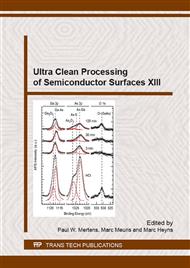[1]
D. Gui, 15th International Symposium on the Physical and Failure Analysis of Integrated Circuits, IPFA (2008).
Google Scholar
[2]
P. Garnier, Metal removal efficiency in deep submicron trenches by wet chemicals. Solid state phenomena, Vol. 219, 2014, pp.32-35.
DOI: 10.4028/www.scientific.net/ssp.219.32
Google Scholar
[3]
F. Domengie, Study of Metal Contamination in CMOS Image Sensors by Dark-Current and Deep-Level Transient Spectroscopies, journal of electronic materials, Vol. 39, N°6, (2010).
DOI: 10.1007/s11664-010-1212-6
Google Scholar
[4]
S. Verhaverbeke, the effect of metallic impurities on the dielectric breakdown of oxides and some new ways of avoiding them, IEDM, 1988, pp.71-74.
DOI: 10.1109/iedm.1991.235421
Google Scholar
[5]
J. L. Baltzinger, Correlation of metallic contamination with gate disturb failure mechanism on EEPROM cell: data analysis and process robustness improvement for contamination free manufacturing, ASMC, 2007, pp.133-138.
DOI: 10.1109/asmc.2007.375095
Google Scholar
[6]
I. Nakao, a simulation model for wet cleaning of deep trenches, J. Electrochem. Soc., Vol. 137, 1990, pp.2303-2305.
DOI: 10.1149/1.2086931
Google Scholar
[7]
K. Ota, Liquid infiltration mechanism for cleaning in deep microholes, ECS Trans. Vol 11, 2007, pp.299-306.
DOI: 10.1149/1.2779392
Google Scholar
[8]
C. Virgilio, Wetting characterization of high aspect ratio nanostructures by gigahertz acoustic reflectometry, International journal of medical and health sciences Vol: 3, No: 3, (2016).
Google Scholar
[9]
H. Aoki, cleaning for deep submicron structures, J. Electrochem. Soc., Vol. 99, pp.102-113.
Google Scholar
[10]
D. Zamani, Surface cleaning of small structures during spin rinsing of patterned substrates, Microelectronic Engineering, 2013, Vol. 108, pp.57-65.
DOI: 10.1016/j.mee.2013.02.092
Google Scholar
[11]
P. Boelen, Metal contamination removal evaluation for single wafer processing, Solid State Phenomena, Vol. 92, 2003, pp.49-52.
DOI: 10.4028/www.scientific.net/ssp.92.49
Google Scholar


